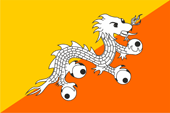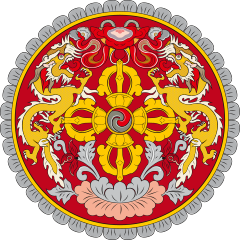Bhutan |
|
|
|
| Übersicht – Contents: | |
Bhutan |
|
|
|
| Übersicht – Contents: | |
Flagge – Flag: |
|
 |
Nationalflagge – national flag, Seitenverhältnis – ratio = 2:3, Quelle/Source: Corel Draw 4, Wikipedia (D) |
historische Flagge – historical Flag: |
|
 |
1949 - 1956, Nationalflagge – national flag, Seitenverhältnis – ratio = 1:1, Quelle/Source nach/by: World Statesmen, Flags of the World |
 |
1956 - 1969, Nationalflagge – national flag, Seitenverhältnis – ratio = 4:5, Quelle/Source nach/by: World Statesmen, Flags of the World |
Bedeutung/Ursprung der Flagge – Meaning/Origin of the Flag: |
|
| Die Flagge von Bhutan ist diagonal Gelb (eigentlich Saffrangelb) über Orange geteilt, und zeigt in der Mitte – über allem – einen weißen, zum wehenden Ende der Flagge blickenden Drachen. Das tibetische Wort für Bhutan ist "Druk Yul", was "Drachenreich" heißt. Die Flagge geht auf eine Initiative des Königs im Jahre 1949 zurück. Der erste Version war quadratisch, diagonal Gelb über Rot geteilt und der Drache war grün. In den 50-er Jahren des 20. Jahrhunderts wurde der Drache in Richtung Fahnenmast ausgerichtet, so dass er gegen den Wind blickt und die Seitenverhältnisse der Flagge auf 3:4 angepasst. 1969 wurden Veränderungen an der Flagge vorgenommen. Der Drache schaut jetzt wieder vom Fahnenmast weg, und das Rot in der Flagge wurde durch Orange ersetzt und die Seitenverhältnisse der Flagge auf 2:3 angepasst. Der Drache hält in jedem seiner Fänge eine Kugel, und steht für das Universum. Jene Kugel, welche der Drache ein wenig nach oben hält, soll die Erdkugel sein, und auf manchen Darstellungen schlagen sogar Flammen aus ihr heraus. Safrangelb steht, wie eigentlich im gesamten hinterasiatischen Raum, für die weltliche Macht des Königs, und Orangerot für die geistliche Macht des Buddhismus. Die weiße Farbe verkörpert Sauberkeit und Ehrlichkeit. |
The flag of Bhutan is
divided diagonally yellow (actually saffron yellow) over orange, and shows
in the middle – above all – a white dragon looking to the waving end of the
flag. The Tibetan word for Bhutan is "Druk Yul", what means "Dragon Empire".
The flag goes back to an initiative of the king in 1949. The first version was square, diagonally divided yellow over red and the dragon was green. In the 50s of the 20th century, the dragon was oriented towards the flagpole so that it faces the wind and the aspect ratio of the flag was adjusted to 3:4. In 1969 changes were made to the flag. The dragon is now looking away from the flagpole again, and the red in the flag has been replaced by orange and the aspect ratio of the flag has been adjusted to 2:3. The dragon holds a sphere in each of its fangs and represents the universe. That sphere, which the dragon holds up a little, is supposed to be the globe, and on some representations even flames burst out of it. Saffron yellow stands for the secular power of the king, and orange red for the spiritual power of Buddhism. The white color embodies cleanliness and honesty. |
| Quelle/Source: Die Welt der Flaggen, Flaggen Wappen Hymnen, World Statesmen, Flags of the World | |
Wappen – Coat of Arms: |
|
 |
seit 1980, Wappen von Bhutan – coat of arms of Bhutan, Quelle/Source nach/by: Wikipedia (DE), Public domain, via Wikimedia Commons |
Bedeutung/Ursprung des Wappens – Meaning/Origin of the Coat of Arms: |
|
| Das Staatswappen von Bhutan wurde im Jahre 1980 neu entworfen. Es zeigt ein Vajra-Rad, ein Symbol das für Undurchdringbarkeit, Unaufbrechbarkeit, Unteilbarkeit, Unzerstörbarkeit und Erleuchtung steht. Das Rad wird durch zwei Drachen beschützt. Sie stehen jeweils für die weltliche bzw. geistliche Autorität. Unterhalb des Rades befindet sich zwischen den Drachen eine Lotosblume, ein buddhistisches Emblem. Oberhalb des Rades ist der Edelstein "Umbrella" abgebildet. Nach anderen Quellen sei diese Abbildung ein Sonnenschirm, ein buddhistischen Schutzzeichen, aber wahrscheinlich handelt es sich bei dieser Interpretation um eine etwas unglückliche wortwörtliche übersetzung des Wortes "Umbrella". |
The national coat of arms
of Bhutan was redesigned in 1980. It shows a vajra-wheel, a symbol that
stands for impenetrability, indissolubility, indivisibility,
indestructibility and enlightenment. The wheel is protected by two dragons. They each stand for the secular and spiritual authority. Below the wheel, between the dragons, is placed a lotus flower, a Buddhist emblem. The gemstone "Umbrella" is shown above the wheel. According to other sources, this figure is a parasol, even a Buddhist symbol, but this interpretation is probably a somewhat unfortunate literal translation of the word "umbrella". |
| Quelle/Source: Flaggen Wappen Hymnen, 1.) Wikipedia (DE) 2.) Wikipedia (DE) | |
Flugzeugkokarde – aircraft roundel: |
|
 |
Flugzeugkokarde – aircraft roundel, Quelle/Source: nach/by Wikipedia (EN) |
| Landkarten – Maps: |
Lage – Position: |
Landkarte des Landes – Map of the Country: |
Zahlen und Fakten – Numbers and Facts: |
|
|
|
|
|
|
|
|
|
|
|
|
|
|
|
|
|
|
|
Geschichte: |
| frühes
Mittelalter · Die Region wird vom Volk der Thepu bevölkert, Herausbildung eines
hinduistischen Fürstentums, das unter die Herrschaft Tibets kommt. Durch Vermischung von
Thepu und Tibetern entsteht das Volk der Bhutia 8. Jhd. · Eindringen des Buddhismus 12. Jhd. · der Buddhismus wird Staatsreligion 1189 · Gründung des Klosters Druk Sewa Jangchubling 1557 · Der Stammesfürst der Bhutia, Schabdung Rimpoche Nawang Namgyal, reißt die Macht an sich und gründet den Staat Bhutan, der erbittert gegen Tibet verteidigt wird. 1592 · Tod von Schabdung Rimpoche Nawang Namgyal, laizistische Gewaltenteilung unter einem weltlichen und einem geistlichen Herrscher 1767 · Bhutan kommt unter die Oberhoheit von China 1772 · beginnende britische Einflussnahme 1864 · teilweise britische Okkupation 1895 · pro-britischer Wang-Chuk-Putsch 1907 · Einführung der Erb-Monarchie (Königreich Bhutan unter den Wang-Chuk-Maharadschas) 1910–1947 · Bhutan steht unter dem Protektorat von Großbritannien 1935 · Britisch-Indien akzeptiert die Autonomie Bhutans 1949 · Indien übernimmt das britische Protektorat 1954 · Bildung eines ersten Parlaments 1968 · Bildung einer ersten Regierung 1971 · das indische Protektorat endet seit 1990 · die Regierung betreibt eine gegen die Überfremdung durch nepalesische Einwanderer gerichtete restriktive Politik |
History: |
| Early Middle
Ages · The region is inhabited by the people of Thepu, formation of a Hindu
principality which comes under the rule of Tibet. By mixing of Thepu and Tibetans formes
the people of the Bhutia 8th century · penetration of Buddhism 12th century · Buddhism is the state religion 1189 · foundation of the monastery Druk Seva Yangchoobling 1557 · The chieftain of the Bhutia, Shabdung Rimpoche Nawang Namgyal, takes over the power and founds the State of Bhutan, which is defended fiercely against Tibet 1592 · death of Shabdung Rimpoche Nawang Namgyal, laizistic separation of the power under a secular and a spiritual ruler 1767 · Bhutan comes under the suzerainty of China 1772 · beginning British influencing 1864 · partial British occupation 1895 · pro-British Wang-Chuk-revolt 1907 · introduction of hereditary monarchy (Kingdom of Bhutan under the Wang-Chuk Maharajas) 1910–1947 · Bhutan is under the protectorate of the United Kingdom 1935 · British India accepts the autonomy of Bhutan 1949 · India assumes the British protectorate 1954 · formation a first Parliament 1968 · formation a first government 1971 · the Indian protectorate ends since 1990 · the government pursues a restrictive policy against foreign infiltration by Nepalese immigrants |
| Quelle/Source:
Weltgeschichte,
World Statesmen,
Wikipedia (D) Translator of the English text (partial): Joachim Nuthack |
Ursprung des Landesnamens – Origin of the Country's Name: |
|
| Der Name "Bhutan" ist aus den Sanskrit-Wörtern "Bhota" und "Anta" abgeleitet. "Bhota" ist der altindische Name von Tibet, und "Anta" heißt Ende (im Sinne von Rand). Bhutan ist also: "Der Rand Tibets". | The name "Bhutan" is derived from the Sanskrit words "Bhota" and "Anta". "Bhota" is the ancient Indian name for Tibet, "Anta" is the End (in the sense of Boundary). Bhutan is: "The Boundary of Tibet." |
| Die Bhutias nennen ihr Land "Druk Jul", was "Drachenreich" heißt. Der Landesname geht auf den Namen des Klosters "Druk Sewa Jangchubling" zurück, das zur Zeit der Gründung des Staates das administrative Zentrum des Landes war. | The Bhutia call their country "Druk Jul", which means "Dragon's Empire". The country's name derives from the name of the monastery "Druk Seva Yangchoobling", that was at the time of the creation of the state the administrative center of the country. |
| Quelle/Source: Handbuch der geographischen Namen, World Statesmen, Volker Preuss | |